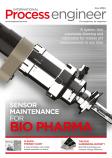Hydrostatic spindle bearings ensure maximum part precision, excellent tool life and high machine availability with low servicing costs
In turning, grinding or milling machines, spindle bearings with roller bearings have been used predominantly up to now. Growing demands for shaping accuracy, dimensional stability, surface quality and removal rate, however, are bringing spindles with roller bearings ever closer to their limits.
While new high-quality spindle bearings with roller bearings can achieve concentricity qualities of approximately 1 µm, the running quality decreases rapidly at high stresses and speeds. This means that the bearings in fast-turning interior grinding spindles have to be replaced after only a few months.
Spindle bearings with roller bearings are only slightly damped. This has direct effects on the surface quality of the part. It also means that tool working lives and the boundary cutting line are somewhat limited.
In addition, fast-running spindle bearings with roller bearings frequently develop very high temperatures, through which the thermal stability of machine suffers, despite costly cooling measures.
This is where hydrostatic spindle bearings come into their own.
If spindle bearings with roller bearings are compared with hydrostatic spindle bearings, hydrostatic embodiments achieve the following advantages.
General advantages of hydrostatic machine components, especially spindle bearings include freedom from wear. Hydrostatic bearings are contactless and therefore free from wear. The properties therefore remain unchanged regardless of the duration of use, stress and speed.
Concentricity
Depending on the spindle size, maximum speed and spindle configuration, the concentricity of hydrostatic spindle bearings and turntables is between 0.03 µm and 0,3 µm, typically 0.1 µm – and this is regardless of the duration of use.
Ideally designed hydrostatic spindle bearings have damping that is many times greater than roller bearing spindles. In addition to longer tool lives, better surface qualities and lower shaping errors are achieved. Chattering only occurs at significantly higher cutting rates.
With hydrostatic bearings, frictional power only occurs in the oil. As this is transported very quickly from the bearing with less wetted surfaces, the bearing remains cool even at very high speeds. The bearing fluid is cooled outside the bearing.
Amortisation
In high-quality machines, the extra cost through using a hydrostatic spindle bearing is approximately 2 to 3%. If the machine is automated, this is even less. Advantages accrue through higher machine availability, lower servicing and tool costs, faster machining times and improved part accuracy. In a gear grinding machine, for example, a significant improvement of the grinding power by the avoidance of burn marks and patently lower shaping errors were achieved, so that an amortisation period of a fraction of a year can be expected. In multi-shift operation, the amortisation period is even significantly shorter.
Conventionally, capillaries (meaning solid resistances) are used for hydrostatic bearings to regulate oil flows between a supply pump and the hydrostatic bags. As a result, increasingly stressed bags are assigned a reduced oil flow, while unstressed bags are assigned a higher oil flow, resulting in low stiffness of the bearing.
Instead of capillaries, however, Hyprostatik uses progressive volume controllers (PV controllers) with which an increasingly stressed hydrostatic bag is assigned more oil, but a destressed bag is assigned less oil. By doing this, Hyprostatik achieves, compared with bearings with capillaries, a stiffness four to five times greater and a less viscous oil can be used, which means that maximum turning speeds can be raised by around 70%. Also, due to the PV controllers, spindle bearings can be fully stressed even at very high speeds, which is not possible in solutions with capillaries. In addition, oil flow, pump pressure and oil heating are patently reduced by using a PV controller.
Hyprostatik works with its own computing programme to ensure that hydrostatic spindle bearings are ideally designed to stand up to static and even vibrating stresses. The data is used to modify the bearing design and oil supply, so that the best possible damping is achieved.
The high stiffness and damping of these spindle bearings enables balancing qualities in the range G0.04; G0.1 can be guaranteed (the smallest balancing quality according to the standard is G0.4).


















